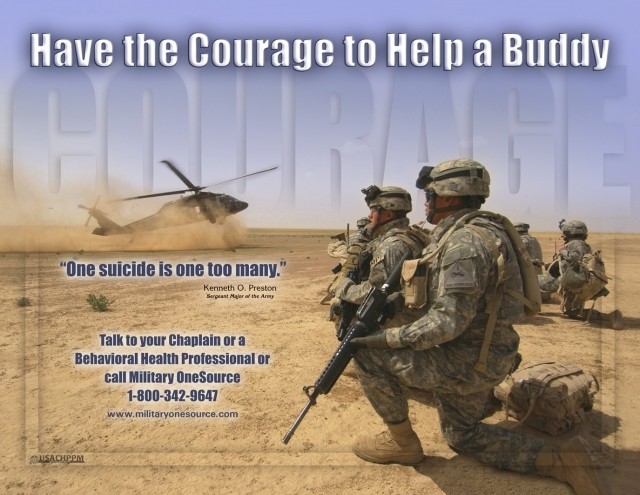WASHINGTON (Army News Service, Jan. 29, 2009) -- The number of suicides in the Army has risen again, for the fourth year in a row, and the problem is being addressed with an Army-wide "stand-down" and chain-teaching program.
The Army experienced 128 confirmed suicides in 2008, up from 115 in 2007, said Army leaders during a media roundtable Jan. 29. An additional 15 deaths are being investigated as suspected suicides, though Army experts say experience has shown that as many as 90 percent of suspected suicides are eventually classified as confirmed.
"The numbers represent tragedies that have taken place across our Army," said Secretary of the Army Pete Geren. Adding that the Army is doing all it can to address the problem. "Every suicide is a tragedy we take personally in the Army."
The secretary said if the Army is to succeed in counteracting the rising trend in suicides in the service, all components of the Army -- including the active-duty, Reserve and National Guard components -- must work together and also work with other organizations such as the Veteran's Administration. To facilitate that collaboration, he appointed Vice Chief of Staff of the Army Gen. Peter Chiarelli to lead those efforts.
"We felt it was necessary to have a central figure at the top ranks of the Army to reach across those components and bring about the kind of progress we hope to achieve," Geren said.
Chiarelli said the Army must work quickly to reduce the trend of suicides in the Army, saying that if the suspected suicides did in fact turn out to be confirmed suicides, the Army's rate for suicides would rise to about 20.2 per 100,000 individuals.
"That number is particularly noteworthy, because the last reported numbers from the Center for Disease Control -- which lags behind, was 19.2," Chiarelli said. "That's important because the Army has always had a suicide rate quite a few numbers below the CDC rate -- the average American rate."
Chiarelli has directed an Army "stand-down" to address the problem, between Feb. 15 and March 15. During that time, he said, commanders will take time to direct the problem "head on," the general said, adding that the service is prepositioning materials for commanders to use when talking with Soldiers.
The general also said the Army would follow the stand-down with a chain-teaching program -- an Army method used to ensure every individual Soldier has been exposed to new material -- during the 120-day period after March 15.
"The second thing that is absolutely critical is to reach out to Soldiers and tell them it is not wrong to reach out for help," Chiarelli said. "We have to change our culture."
In the past, he said, it has been a culture in all the military services, that accessing mental health resources was detrimental to a servicemember's career.
"That is something we have got to turn around," he said. "We are committed to doing that. And that is all leaders -- review what they have done in the past, what has helped us in the past -- and continue to do those. At the same time, to reach out to their Soldiers and make sure there is no stigma."
The Army's stand-down will include training to help Soldiers recognize suicidal behavior in their fellow Soldiers, as well as teach them techniques to intervene.
While Secretary Geren has said the Army is unsure exactly why the numbers of suicides have risen over the last four years, Chiarelli said stress was probably a factor.
"There is no doubt in my mind that stress is a factor in this trend we are seeing," Chiarelli said. He also added that about a third of the suicides were amongst those deployed, a third were amongst those who had returned from deployment, and a third were amongst those who have had no history of deployment.
Army leaders also said that traditionally it has been both relationship and financial problems that have contributed to Soldier suicides -- and that increased deployment lengths then may contribute to suicides by adding additional stress on families and relationships.
Secretary Geren said when tour lengths were increased to 15 months, the Army worked to alleviate some of the stress that would be created between Soldiers and their families by adding additional funding to Army family programs.
"That's when we started trying to hire additional mental health workers, when we started putting additional resources into family support -- trying to reduce stress on the families and the stress on the Soldier who is worrying about the family back home," Geren said. "You saw a tremendous reallocation of resources within the Army budget."
Geren said the Army has changed the family support budget from $700 million to nearly $1.5 billion.
"We saw the stress, we recognized it, and we started putting resources to that challenge," he said. "I can tell you, senior leadership knew -- we could feel the pressure -- and we started moving resources to address those issues."
In October, Army senior leaders signed a memorandum of agreement with the National Institute of Mental Health to conduct a study to get to the root causes of why Soldiers commit suicide.
Under the MOA, the NIMH will conduct research for the Army that will evaluate the many factors that contribute to suicide. The results of the study will be used by the Army to develop strategies to prevent suicides.
The study is expected to last five years, during which time the NIMH may interview Soldiers, their families and their parents. The study will include the active-duty force in addition to the National Guard and Army Reserve.




Social Sharing